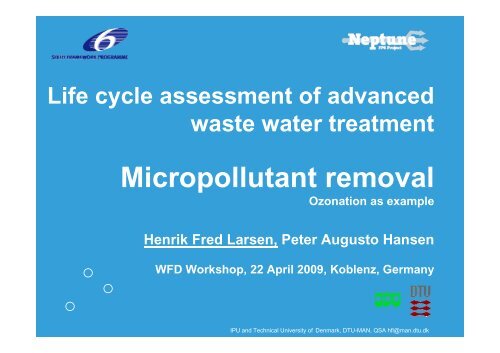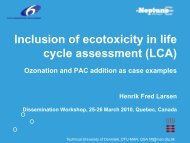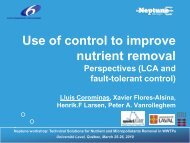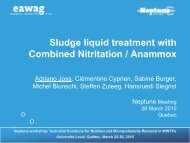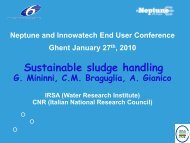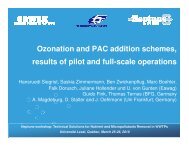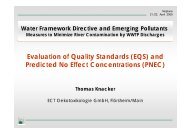Micropollutant removal - EU Project Neptune
Micropollutant removal - EU Project Neptune
Micropollutant removal - EU Project Neptune
- No tags were found...
You also want an ePaper? Increase the reach of your titles
YUMPU automatically turns print PDFs into web optimized ePapers that Google loves.
Life cycle assessment of advancedwaste water treatment<strong>Micropollutant</strong> <strong>removal</strong>Ozonation as exampleHenrik Fred Larsen, Peter Augusto HansenWFD Workshop, 22 April 2009, Koblenz, GermanyIPU and Technical University of Denmark, DTU-MAN, QSA hfl@man.dtu.dk
Outline The holistic challenge when introducing new wastewater treatment technologies for micropollutants<strong>removal</strong>; avoid sub optimisation Avoided and induced impacts Characteristics of life cycle assessment (LCA) Modelling LCA on ozonation Characterisation of incoming water Environmental sustainability profiles for ozonation The effect of including sand filtration Conclusion and further research2
Peter Augusto Hansen3
Peter Augusto Hansen4
Inducedimpact:(impact construction +impact operation +impact disposal)PLANTCONSTRUCTIONMaterials (kg)Life time of plant (years)PLANT OPERATIONEnergy (kWh/d)Chemicals (kg/d)Emissions (kg/d)PLANT DISPOSALMaterials (kg)(disposal ways)WWTT(m 3 /d) Wetlands Sand filtration(m 3 /d)Activated carbonOzonationAvoidedimpact:(impact influent ÷impact effluent)INFLUENTSubstance Concentration(mg/m 3 )4-MBC 23DEHP 50Ibuprofen 10DeBDE 8Trimethoprim 2- -- -EFFLUENTSubstance Concentration(mg/m 3 )4-MBC 5DEHP 30Ibuprofen 2DeBDE 1Trimethoprim 1- -- -5
Characteristics of LCA• A decision supporting tool• Focus on services typically represented by a product (the“functional unit”, fu). In this case: Treatment of one cubic meterwaste water (all impacts related to this unit)• Comparative (relative statements). In this case: Comparinginduced impacts with avoided impacts regarding ozonation• Holistic perspective– life cycle from cradle to grave– all relevant environmental impacts or damages to ‘areas of protection’. In this case:Global warming, eutrofication, acidification, ecotoxicity…..…– resource consumption (biotic and abiotic). This case: Metals (Ni), fossil fuels, ….. (NOTINCLUDED HERE)• Aggregation over time and space– life cycle is global– life cycle may span over decades or even centuries6
Elements of life cycle assessment (LCA)Goal & scopedefinitionApplication:InventoryanalysisImpactassessmentInterpretationDecision supportingguideline for waste watertreatment technologies:Environmental sustainabilityof ozonation7
Goal and scope,Goal & scopedefinitionand inventoryInventoryanalysisInterpretationApplication:Decision supportingguideline for waste watertreatment technologiesImpactassessment• Goal– An assessment of the environmental sustainability of ozonation• Scope– Comparative LCA: Induced impacts as compared to avoided impacts– Functional Unit(s): 1 m 3 secondary MWWTP effluent water with well definedcomposition as regards content of micropollutants and more• Inventory– collecting in- and output data for all processes8
Life cycle impactassessment (LCIA)Goal & scopedefinitionInventoryanalysisInterpretationApplication:Decision supportingguideline for waste watertreatment technologiesImpactassessmentClassification: “What does this emission or consumptioncontribute to?”• Assignment of emissions and consumptions to impact categories according totheir potential effects– Global warming (e.g. CO 2 , CH 4 )– Acidification (e.g. NO 2 , SO 3 )– Ecotoxicity (e.g. pharmaceuticals, heavy metals)– Human toxicity (e.g. benzene, PAH’s)– ………..Characterisation: “How much may it contribute?”• Quantification of contributions to the different impact categories (e.g. multiplying thecharacterisation factors for each chemical by the emitted amount)• Example: Emission of 100g CO 2 + 100g CH 4 contributes with: 100*1g CO 2 -eq/g CO 2 +100*25g CO 2 -eq/g CH 4 = 2600 g CO 2 -eq9
Life cycle impactassessment (LCIA)and interpretationGoal & scopedefinitionInventoryanalysisImpactassessmentInterpretationApplication:Decision supportingguideline for waste watertreatment technologiesNormalisation: “Is that much?”• Expression of the impact potentials relative to a reference situation (EDIP: personequivalence),e.g. NR: 8,700 kg CO 2 -eq/pers/year.– Example: If the treatment of 1 m 3 waste water (1 fu) results in a total emission of 0.5 kg CO 2-eq => Normalized impact potential:0.5/8,700 = 0.057 mPE/fuValuation: “Is it important?”• Ranking, grouping or assignment of weights to the different impact potentials (EDIP: politicalreduction targets), e.g. for global warming the targeted 10 years reduction 20% => WF=1/(1-0.2) = 1.3.– Example: Weighted impact potential: 1.3*0.057 = 0.074 mPET/fuInterpretation: “Which alternative is better and what determines it?”• Is ozonation worth it in an environmental sustainability context or should we avoid it• Identification of hot spots• Sensitivity analysis: Effect of including more micropollutants• Sensitivity analysis: Effect of using alternative valuation principles10
Modelling LCA on ozonation; Main plan(physical inventory)Ozonation (2.8gO3/m3WW, Hunziker)-hfl-March-2009GaBi 4 process plan:Reference quantitiesThe names of the basic processes are shown.InfrastructureOzonationp X5,5096E-009 pcs.Electromechanical equipment2,7548E-009 pcs.Buildings and constructions4,1322E-009 pcs.Pipes and valvesAncilliary0,02044 kgOxygenEnergy0,14 MJCH: electricity, at cogen 500kWe lean burn, allocation exergy11
Modelling LCA on ozonation; Sub-plan(physical inventory)Pipes and valvesGaBi 4 process plan:Reference quantitiesThe names of the basic processes are shown.MaterialsMaterials disposalPipes and valvesp X65 kg9076 kg7247 kgRER: aluminium, production mix, cast alloy, at plantRER: reinforcing steel, at plantRER: steel, electric, chromium steel 18/ 8, at plantRER: copper, at regional storageCH: expanded perlite, at plant28 kg1060 kg7 kgCH: disposal, aluminium, 0% water, to sanitary landfill65 kgCH: disposal, copper, 0% water, to municipal incineration28 kgCH: disposal, inert waste, 5% water, to inert material landfill1060 kgCH: disposal, building, reinforcement steel, to sorting plant7 kg16323 kgCH: disposal, polyethylene, 0.4% water, to municipal incineration13058 kgRER: polyethylene, HDPE, granulate, at plantMaterials transport from plant/ storage to WWTPMaterials reuse/ recyclingCH: transport, lorry >28t, fleet averageRER: iron scrap, at plant (inverted)RER: transport, lorry >16t, fleet average12
Characteristics of incoming water (secondary effluent water)(functional inventory)Inlet conc. (ng/L) Removal rate (2,8 g O 3 /m 3 ) PNEC (µg/L) More rigoruos tired RA based PNECs (µg/L)Atenolol 1400 0,90 330Bezafibrat 170 0,82 2,3Carbamazepin 1100 1,00 2,5 0,5Clarithromycin 210 0,98 0,31Clindamycin 24 0,98 8,5Clofibrinsäure 120 n/a 25 5Diatrizoate 3200 0,31 11000Diclofenac 2600 1,00 100 0,1Erythromycin 130 0,41 0,20 0,02Ibuprofen 130 n/a 96 3Iohexol 540 0,00 7400000Iopamidol 1700 0,00 380000Iopromid 1700 0,19 100000Metoprolol 410 0,94 76 7,3Naproxen 400 0,98 190NDMA (N-nitrosodimethylamin) 57 -3,08 40Primidon 330 0,55 1400Propanolol 120 0,92 0,050Roxithromycin 76 0,79 2,8Sotalol 370 0,98 300Sulfamethoxazol 910 0,99 0,59 0,15Trimethoprim 200 0,98 800(data on <strong>removal</strong> rates from MicroPoll; personal communication with Juliane Hollender)13
Secondary effluent - directly emitted (22 micropollutants)Global warmingLCA impactprofiles(weighting factor = 1 for all impact categories)AcidificationNutrient enrichmentPhotochemical oxidationHuman toxicity soilHuman toxicity waterEcotoxicity soilEcotoxicity waterTotal0 2 4 6 8 10 12 14 16 18µPET/m 3After ozonation; 2,8g ozon/m3 (22 micropollutants)Global warmingAcidificationNutrient enrichmentPhotochemical oxidationHuman toxicity soilHuman toxicity waterEcotoxicity soilEcotoxicity waterTotalAvoided: 14,6 µPET/m3Induced: 8,9 µPET/m30 2 4 6 8 10 12µPET/m 314
Environmental sustainability profiles; ozonation(22 micropollutants; weighting factor = 1 for all impact categories)µPET (WF=1)20191817161514131211109876543210Infrastructure Ancilliary Energy Clarithromy cinClindamy cin Ery thromy cin Roxithromycin Sulfamethox azoleTrimethoprim Bezafibrate Diclofenac IbuprofenNaprox en Carbamazepin Primidone IopamidolIopromid Iohex ol Diatrizoat AtenololMetoprolol Sotalol Propanolol Clofibric acidNDMAInduced Av oided Induced Av oided Induced Av oided Induced Av oided Induced Av oided Induced Av oided Induced Av oided Induced Av oided1.6g O3 1.9g O3 2.8g O3 3.2g O3 3.3g O3 3.6g O3 3.7g O3 5.3g O3Ozonation15
Environmental sustainability profiles; ozonation(22 micropollutants; weighting factor = 1 for all impact categories)Ozonation (avoided ÷ induced)8765µPET (WF=1)43210-1-21.6g O3 1.9g O3 2.8g O3 3.2g O3 3.3g O3 3.6g O3 3.7g O3 5.3g O316
Environmental sustainability profiles; ozonation(22 micropollutants; weighting factor = 1 for all impact categories)µPET (WF=1)20191817161514131211109876543210Infrastructure Ancilliary Energy Clarithromy cinClindamy cin Ery thromy cin Roxithromycin Sulfamethox azoleTrimethoprim Bezafibrate Diclofenac IbuprofenNaprox en Carbamazepin Primidone IopamidolIopromid Iohex ol Diatrizoat AtenololMetoprolol Sotalol Propanolol Clofibric acidNDMAInduced Av oided Induced Av oided Induced Av oided Induced Av oided Induced Av oided Induced Av oided Induced Av oided Induced Av oided1.6g O3 1.9g O3 2.8g O3 3.2g O3 3.3g O3 3.6g O3 3.7g O3 5.3g O3Ozonation17
Environmental sustainability profiles; ozonation(22 micropollutants (only significant ones shown); weighting factor = 1 for all impact categories)µPET (WF=1)20191817161514131211109876543210-1InducedAvoidedNDMAClofibric acidPropanololMetoprololAtenololCarbamazepinIbuprofenDiclofenacBezafibrateSulfamethoxazoleRoxithromycinErythromycinClarithromycinEnergyAncilliaryInfrastructure2.8g O3Ozonation18
40Environmental sustainabilityprofiles; ozonation(22 micropollutants (only significant ones shown); weightingfactor = 1 for all impact categories)Including longtermemissionsµPET (WF=1)3020100InducedAvoidedNDMAClofibric acidPropanololMetoprololAtenololCarbamazepinIbuprofenDiclofenacBezafibrateSulfamethoxazoleRoxithromycinErythromycinClarithromycinEnergyAncilliaryInfrastructureIncluding both longtermemissions and rigorous PNECs2.8g O3Ozonation (with longterm emissions)No longterm emissions, norigorous PNECsµPET (WF=1)20191817161514131211109876543210-1Induced2.8g O3OzonationAvoidedNDMAClofibric acidPropanololMetoprololAtenololCarbamazepinIbuprofenDiclofenacBezafibrateSulfamethoxazoleRoxithromycinErythromycinClarithromycinEnergyAncilliaryInfrastructureµPET (WF=1)1201101009080706050403020100Induced2.8g O3AvoidedOzonation (with both rigorous PNECs and longtermemissions)NDMAClofibric acidPropanololMetoprololAtenololCarbamazepinIbuprofenDiclofenacBezafibrateSulfamethoxazoleRoxithromycinErythromycinClarithromycinEnergyAncilliaryInfrastructure19
Environmental sustainability profiles; ozonation + sand filtration<strong>removal</strong> of aldehydes and WET (22 micropollutants; weighting factor = 1 for all impact categories)µPET (WF=1)252423222120191817161514131211109876543210Infrastructure Ancilliary Energy ClarithromycinClindamycin Erythromycin Roxithromycin SulfamethoxazoleTrimethoprim Bezafibrate Diclofenac IbuprofenNaproxen Carbamazepin Primidone IopamidolIopromid Iohexol Diatrizoat AtenololMetoprolol Sotalol Propanolol Clofibric acidNDMAInducedAvoidedInducedAvoidedInducedAvoidedInducedAvoidedInducedAvoidedInducedAvoidedInducedAvoidedInducedAvoided1.6g O3 1.9g O3 2.8g O3 3.2g O3 3.3g O3 3.6g O3 3.7g O3 5.3g O3Ozonation+sand filtration20
Environmental sustainability profiles; ozonation + sand filtration(22 micropollutants (only significant ones shown); weighting factor = 1 for all impact categories)µPET (WF=1)20191817161514131211109876543210InducedAvoidedNDMAClofibric acidPropanololMetoprololAtenololCarbamazepinIbuprofenDiclofenacBezafibrateSulfamethoxazoleRoxithromycinErythromycinClarithromycinEnergyAncilliaryInfrastructure2.8g O3Ozonation+sand filtration21
Effect of including more micropollutantsozonation + sand filtrationSecondary effluent After sandfiltration Removal rateTotal suspended solids TSS (mg/L) 8 2 0,75mg/kg TSS in secondary sludgeCd 0,33Hg 0,74As 14Ni 21Cr 56Pb 100Cu 270Mn 480Zn 53022
Environmental sustainability profiles; ozonation + sand filtration(31 micropollutants (only significant ones shown); weighting factor = 1 for all impact categories)120110µPET (WF=1)1009080706050403020100Induced2.8g O3AvoidedHeavy metalsNDMAClofibric acidPropanololMetoprololAtenololCarbamazepinIbuprofenDiclofenacBezafibrateSulfamethoxazoleRoxithromycinErythromycinClarithromycinEnergyAncilliaryInfrastructureOzonation+sand filtration23
Environmental sustainability profiles; ozonation + sand filtration(31 micropollutants + P (only significant ones shown); weighting factor = 1 for all impact categories)Secondary effluent After sandfiltration Removal rateTot-P (mg/l) 0,8 0,3 0,625260240µPET (WF=1)220200180160140120100806040200InducedAvoidedTot-PHeavy metalsNDMAClofibric acidPropanololMetoprololAtenololCarbamazepinIbuprofenDiclofenacBezafibrateSulfamethoxazoleRoxithromycinErythromycinClarithromycinEnergyAncilliaryInfrastructure2.8g O3Ozonation+sand filtration24
260240Environmental sustainabilityprofiles; ozonation+ sand filtration(31 micropollutants + P (only significant onesshown); weighting factor = 1 for all impactcategories)µPET (WF=1)220200180160140120100806040200InducedAvoidedTot-PHeavy metalsNDMAClofibric acidPropanololMetoprololAtenololCarbamazepinIbuprofenDiclofenacBezafibrateSulfamethoxazoleRoxithromycinErythromycinClarithromycinEnergyAncilliaryInfrastructureIncluding longtermemissions2.8g O3Ozonation+sand filtration (with longterm emissions)No longterm emissionsµPET (WF=1)260240220200180160140120100806040200Induced2.8g O3Ozonation+sand filtrationAvoidedIncluding both longtermemissions and rigorous PNECsTot-PHeavy metalsNDMAClofibric acidPropanololMetoprololAtenololCarbamazepinIbuprofenDiclofenacBezafibrateSulfamethoxazoleRoxithromycinErythromycinClarithromycinEnergyAncilliaryInfrastructureµPET (WF=1)360340320300280260240220200180160140120100806040200Induced2.8g O3AvoidedOzonation+sand filtration (with both rigorous PNECs andlongterm emissions)Tot-PHeavy metalsNDMAClofibric acidPropanololMetoprololAtenololCarbamazepinIbuprofenDiclofenacBezafibrateSulfamethoxazoleRoxithromycinErythromycinClarithromycinEnergyAncilliaryInfrastructure25
Conclusions and further researchConclusions Based on the given assumptions results indicate that ozonation used for <strong>removal</strong>of organic micropollutants most probably is environmentally sustainable, i.e.avoided potential impacts are higher than induced potential impacts However, problems with whole effluent toxicity and aldehydes Including sand filtration (<strong>removal</strong> of heavy metals and tot-P) significantly improvesthe sustainability profile Focusing on global warming a weighting factor of at least 30 – 45 is needed inorder to reach a break-even between induced and avoided impacts for ozonationcombined with sand filtrationImprovements/further research Including more micropollutants Including pathogens Improving the methodology on longterm emissions Including new methodology on the ecotoxicity impact category (average toxicity,PAF) Including economy (cost-efficiency)26


